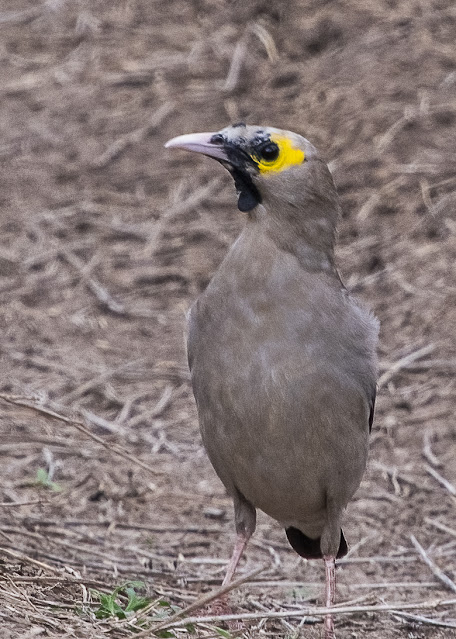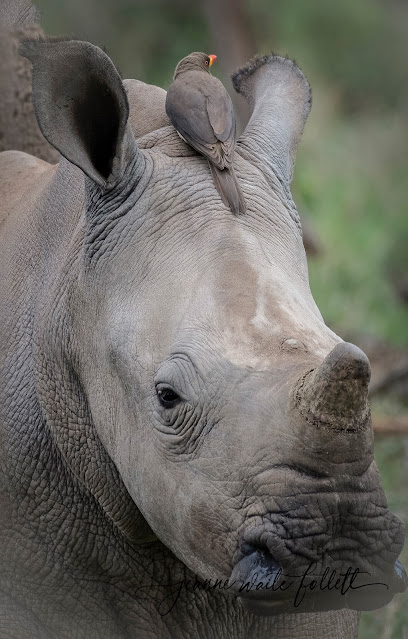Chapter 19
In Which We Hunt the Elusive Black RHino
These
magnificent species of Africa - elephants, rhino, lions, leopards,
cheetah, the great apes (Africa has four of the world's five great apes)
- this is a treasure for all humanity, and they are not for sale. They
are not for trade. They need to be valued and preserved by humanity. We
all need a global commitment to that.
-- Patrick Bergin
Rain is falling as we begin our game drive at 6 A.M. Today, we hope, we will find the black rhinos in the Solio Wildlife Reserve. If not, there are hundreds of white rhinos to be photographed, you might say.
True. But black rhinos are another matter. They are extremely endangered by poachers. As of last year, there were about 5600 black rhinos left in the world. Ninety-eight per cent of those rhinos are found in only four African countries--Kenya, Namibia, Zimbabwe, and South Africa, with the latter country having the majority.
Why are rhinos killed for their horns? Countries like China and Viet Nam value the horn in traditional medicine as a cure for cancer, hangovers, and even impotence. While only the sellers of horns know how much a horn is worth, estimates range from $4000 a pound all the way up to $300,000 for a complete horn.
When you consider that the horn is made of keratin--the same material as human fingernails--the killing of these animals is seen as deplorable in the West. And foolish.
The most current information I could find estimates there are more than 45 black and 185 white rhinos within the Solio reserve. I can easily believe the white rhino count because I think I saw all of them in the grasslands pasture and in the forest during our stay.
The black rhinos? They are far more shy and elusive, preferring to eat leaves from thick brush than grazing on grass. However, we knew there were black rhinos in the reserve and so we were hopeful.
The first thing we see after we pass the gate is this soaking wet northern anteater chat.
A white-browed coucal is next.
A DeFassa waterbuck.
We move into the forest to search there and find a number of Egyptian geese and gray-crowned cranes, as well as a yellow-billed stork.
Deeper in the forest, an African hoopoe poses with its catch.
We find a lilac-breasted roller....
....a red-billed oxpecker on a white rhino.....
...and a speckled mousebird.
In another place, we see an African spoonbill and a sacred ibis...
There are vervets to entertain us, particularly the baby hanging by its tail at left.
Even the unusual wattled starling.
A juvenile fish eagle.
We stop beside a bird's nest that is built immediately next to the trail.
And the anxious parent pacing nearby, a Senegal plover. That a bird would build a nest right next to the trail shows how few visitors come to this area.
We find a giraffe with a baby.
We do not find black rhinos; we do not give up. Instead, our guides take us to a lovely area within the forest and set up breakfast.
GK, one of our guides. The second, Bonnie, can be seen at the left of the left vehicle.
While the guides were setting out breakfast on the hood of the vehicles, I wandered around looking for anything interesting. Then, I noticed my friends were off on a mission in the other direction so I caught up with them to see what they'd found.
Up in the branches of a tall tree, the beautiful Colobus monkeys with their long white tails were watching us. These animals spend virtually all their lives in trees, seldom descending to the ground.
Then, we resumed our search of the black rhino. I began to think we would never find one.
Instead, we see sparring male impalas.
And a baby rhino with a red-billed oxpecker on its head.
Lappet-faced vulture...
Eventually, we must return to the lodge for our mid-day break. No black rhinos as yet.
Late afternoon, we again return to the reserve. A European bee-eater poses nicely. These birds are migrating through so we were lucky to see them.
A white rhino and its calf are in the pasture.
A small group of white rhinos.
In the distance are 15 more rhinos that I can see, as well as a vehicle from the Solio Ranch Lodge, the only other vehicle we see during our three days.
By this time, the sun is low in the sky and our guide takes us through the thickets toward the pasture area. At least we can top off the day with white rhinos....
Suddenly, there they are. Two huge black rhinos in the bushes. For the novice viewer, the triangular upper lip is the identifying feature.








































Another fun Post Gullible. Photo 19 showing that cute baby Giraffe is priceless. And (Photo 2 at the top) the unusual horn on the White Rhino. All of the Rhino photos are most interesting. Photo 30 and the babies. Amazing kind of odd creatures. Photos 36 / 37 / 38 .. Suddenly, there they are. Two huge black rhinos in the bushes. Then they were gone. Too great. And the Monkeys, the Impalas, many birds. Great fun. Cap and Patti
ReplyDelete